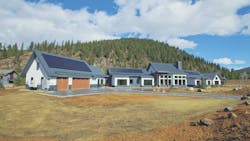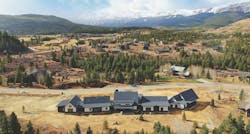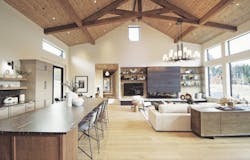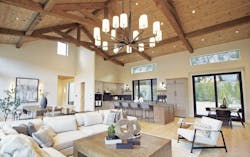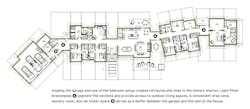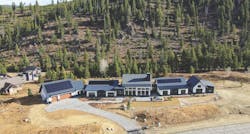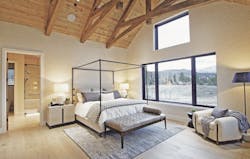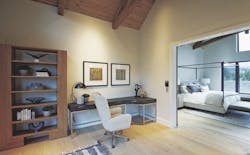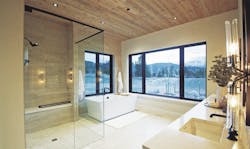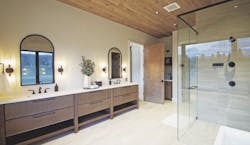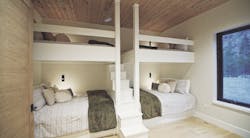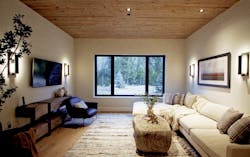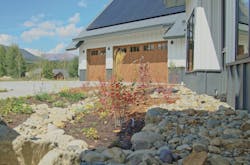Brilliant and Resilient: The Panorama Idea Home
This article first appeared in the November/December 2024 issue of Pro Builder.
As you approach from the modest road that leads to an enclave of second homes in the resort town of Breckenridge, Colo., it’s clear the Panorama Idea Home stands apart from its neighbors. And it does so in more ways than just the home’s bright white board-and-batten siding and slightly jagged form that traverses the long, flat lot.
“I think we settled on ‘modern mountain farmhouse,’” says builder Gene Myers, with a wink to architect Dan Chapman.
But whatever you call it from the outside—and even once you experience the well-scaled, light-filled, and imminently comfortable interior of this 6,600-square-foot home—Panorama House has other names that are equally apt. Net-zero, carbon-neutral, all-electric, fire-resilient, drought-tolerant, and healthy all apply, and these performance goals have been accomplished in a climate zone primarily found in Alaska, arguably the country’s harshest environment. “If we can build to those standards here,” Myers says, “it can be done anywhere.”
Project Specs: Panorama Idea Home
Location: Breckenridge, Colo.
Builder: Thrive Home Builders, Denver
Architect: Allen-Guerra Architecture, Frisco, Colo.
Interior designer: TRIO, Denver
Size: 6,600 square feet
Bedrooms: 6
Bathrooms: 6 full, 2 half
Photos: Insignia Studios
A Custom Home That Serves a Dual Purpose
Panorama House, the latest Pro Builder Idea Home, is a passion project for Denver-based Thrive Home Builders, a medium-volume production shop founded by Myers, who now serves as the company’s chief sustainability officer.
But the custom home is also a model, Myers says, for other production builders to follow; a model he thinks is necessary to both sustain the built environment and to provide mid-size and small-volume builders with an increasingly marketable selling point that gives them an edge over national and large regional competitors.
RELATED
- Learn About Select Products Used in the Panorama Idea Home
- The Picket Fence Idea Home—a New Blueprint for Urban Living
- Introducing The House That Blues Built
“How does a small builder really make a difference?” Myers asks. “One could easily say you can’t. But over the course of my career, I’ve learned that builders aren’t called to do what we can’t do but what we can do. And this house shows what can be done.”
While bigger builders that lean into resource-efficient, better-performing, and durable homes may have the collective volume to move that needle into the mainstream, smaller builders have perhaps a greater stake and reason to lead that charge.
“If we aren’t part of the solution, helping regulators figure out how to regulate, it’ll be regulated upon us,” Myers says of increasingly stringent and inflexible building and energy codes and standards. “We have a saying at Thrive, that if you’re not at the table, you might be on the menu.”
But performance is only half of the picture at Panorama. The flip side is the home’s appeal, both visually and, perhaps more importantly, how the home feels.
“One of our primary goals was to design spaces that are not only respectful of the environment and its surroundings but of the inhabitants, too,” says Sydney Piwowar, design director at TRIO, Panorama’s interior designer.
Brought in at the beginning of the process, the TRIO team conferred early and often with both Myers and Chapman’s team at Allen-Guerra Architecture about how the home’s eventual occupants would live in their environment.
“When we can harness that insight, we’re able to tap into a subconscious level of everyday living so the house is working symbiotically with nature and with their lives,” Piwowar says.
Chapman agrees. “A connection to nature is a greater part of the sustainability narrative,” he says. “The house feels good, it looks good, and ultimately, it lives well.”
Myers puts a finer point on it from a builder’s perspective, one he admits he only recently realized after 30 years of dedicating his company to delivering high-performance, healthy homes.
But performance is only half of the picture at the Panorama Idea Home. The flip side is the home’s appeal, both visually and, perhaps more importantly, how the home feels.
“I think there’s an inherent assumption by consumers that living sustainably involves sacrifice,” he says. “We want to show that there is a mainstream market for doing the right thing, but the hook is that it must also be beautiful and livable.”
That was one of Chapman’s challenges as he started to design. “With sustainability, you don’t want the house to look different and weird,” he says.
So the team took a comfortable, familiar approach to the home’s design that considered not just the path of the sun along the building’s front elevation but the home’s flat, rambling, two-acre lot as well. “The site really called for a one-story adaptation of the farmhouse tradition,” Chapman says; the concept of a large original structure that is added to over time, leaving a somewhat jagged form that naturally stretches out on either side. “We didn’t want it to feel like a big, monolithic thing.”
Lessons Learned From the Project
Despite Thrive’s decades-long award-winning commitment to sustainable home building, Panorama presented its share of challenges, missteps, and restarts.
“We had the attitude of let’s fail forward,” Myers says. “Instead of saying, ‘We’ll never do that again,’ we said, ‘Let’s find out what went wrong and learn from it.’”
One key challenge early on was Myers’ desire to use an off-site building system to help speed the home’s production ahead of winter weather that routinely dumps some 30 feet of snow.
Initially, Myers was going to use volumetric modular construction, but he pivoted to open-frame wall panels, timber-framed roof trusses, and panelized floor systems from a small, local supplier instead. The off-site outfit needed three tries to get the trusses right, but the upshot was beautiful exposed-beam ceilings and a faster framing schedule. And now, Myers says, “He’s probably the most sophisticated off-site construction framer in the state!”
“We had the attitude of Let’s fail forward. ... Let’s find out what went wrong and learn from it.” —Gene Myers
Accurate and meticulous installation of flashing and weather barriers, and air sealing, among several other products and best practices, was critical to achieving the home’s performance goals.
But the production team soon discovered a gap between its historically high building standards and specifications and the familiarity and skill level of the local labor pool to execute them.
On-site training in proper installation of the weather-resistant barriers and exterior cladding by the respective manufacturers was critical in getting crews up to speed, as was a tireless work ethic and genuine curiosity among the workers.
“We proved that the industry can move forward with technology without leaving the local workforce in the dust,” Myers says. “In fact, it’s a way to extend their careers. And no one can ever take that knowledge and skill set away from them.”
Below Zero: Building a Net-Zero, Zero Carbon Home
Temperatures in the low 20s may seem idyllic for the skiers and snowboarders who flock to Breckenridge each winter, but for Panorama, zero (as in net-zero energy and zero carbon) was always the goal. But it wasn’t easy.
“The last five points of a HERS [Home Energy Rating System] rating to get to net zero energy use are the hardest,” Myers says.
For Panorama, that journey started with a deep dive into calculating the home’s carbon footprint, followed by careful review of every material, component, and system to ensure the final product meets the carbon-neutral standard.
“A couple of years ago, it was a lot harder to make smart decisions about furnishings and finishes,” Piwowar says. Back then, there was little transparency about a product’s makeup or manufacture. But times have rapidly changed. “There’s a lot more data available now for us to make good decisions.”
But Panorama challenged the team to go deeper. “What does it take to use that product, install it, and maintain it? What’s its lifespan? Is it going to stand the test of time and everyday use,” she says, beyond the basics of energy or water consumption? “We wanted to get to that level to make the best decisions that were going to get us to net-zero energy.”
Chapman is convinced those efforts for Panorama will pay off well beyond this particular project. “We really walked the talk,” he says. “And I think our approach is only going to move more and more to the forefront of design and construction.”
True to form, Myers and Thrive took a practical tack when it came to achieving those last five HERS points. “We ‘tweaked’ the windows,” he says, by specifying U-factors and heat gain coefficients for the expansive triple-pane windows that are especially effective at letting in sunlight along the home’s east-facing elevation and subduing the heat gain from the windows facing west.
Thinking Beyond the Bottom Line for Long-Term Sustainability
As a production builder, Thrive Home Builders feels the pressure to save every nickel and cut some corners to make projects pencil out. The builder simply chooses not to bow to that pressure and instead seeks to raise awareness about the built environment and builders’ responsibility to deliver better homes that do their part to help combat climate change.
“Home builders are actually environmentalists, we just deal in the human environment, but we’re part of the overall environment,” Myers says. “And if we do a good job of serving the human environment while respecting the rest of the environment, that’s how we take sustainability to the mainstream.”
About the Author
Andrew Hunt
Andrew Hunt writes about building science and the built environment.

Rich Binsacca
Rich Binsacca is editorial director of Pro Builder Media and Custom Builder Online. He has reported and written about all aspects of the housing industry since 1987 and most recently was editor-in-chief of Pro Builder Media. [email protected]
